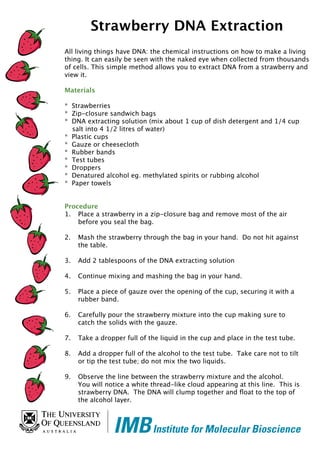
Strawberry dn aextraction
- 1. Strawberry DNA Extraction All living things have DNA: the chemical instructions on how to make a living thing. It can easily be seen with the naked eye when collected from thousands of cells. This simple method allows you to extract DNA from a strawberry and view it. Materials * * * * * * * * * * Strawberries Zip-closure sandwich bags DNA extracting solution (mix about 1 cup of dish detergent and 1/4 cup salt into 4 1/2 litres of water) Plastic cups Gauze or cheesecloth Rubber bands Test tubes Droppers Denatured alcohol eg. methylated spirits or rubbing alcohol Paper towels Procedure 1. Place a strawberry in a zip-closure bag and remove most of the air before you seal the bag. 2. Mash the strawberry through the bag in your hand. Do not hit against the table. 3. Add 2 tablespoons of the DNA extracting solution 4. Continue mixing and mashing the bag in your hand. 5. Place a piece of gauze over the opening of the cup, securing it with a rubber band. 6. Carefully pour the strawberry mixture into the cup making sure to catch the solids with the gauze. 7. Take a dropper full of the liquid in the cup and place in the test tube. 8. Add a dropper full of the alcohol to the test tube. Take care not to tilt or tip the test tube; do not mix the two liquids. 9. Observe the line between the strawberry mixture and the alcohol. You will notice a white thread-like cloud appearing at this line. This is strawberry DNA. The DNA will clump together and float to the top of the alcohol layer.
- 2. More Information about DNA Below is more information on DNA, and how the experiment works to extract and make visible this tiny molecule. What does DNA stand for? DNA stands for deoxyribonucleic acid. DNA is a molecule in the form of a double helix - two spirals twisting around each other. These spirals are the backbone of the DNA, and are made up of sugars and phosphates. The spirals are connected by chemicals known as bases, which stretch between the spirals like the rungs of a ladder. DNA has four types of bases: adenine (A), thymine (T), guanine (G) and cytosine (C). A and T always join together, as do G and C. What does DNA do? DNA is the genetic instruction manual for making an organism. All processes in the body are controlled by DNA. A gene is a sequence of DNA. Genes in Common You don’t look much like a fly or a worm. But, believe it or not, you share genes with both of them - and with every other living organism. Scientists study the genes in bacteria, fish, chimpanzees and other living things to learn more about humans. How much DNA do you share with these living things? Fruit fly - 36% Chimpanzee - 98% Zebrafish - 85% Bacteria - 7% Mustard Grass - 15% Round Worm - 21% Why do we use the dishwashing liquid? The dishwashing liquid busts open the cells of the strawberries, releasing the DNA. Why do we use the salt? It ensures that the proteins in the cell are not separated from the rest of the solution with the DNA. What does the alcohol contribute to the experiment? When molecules are insoluble (unable to be dissolved), they clump together and become visible. DNA is not soluble in alcohol; therefore, it makes the DNA strands clump together and become visible to the naked eye.
